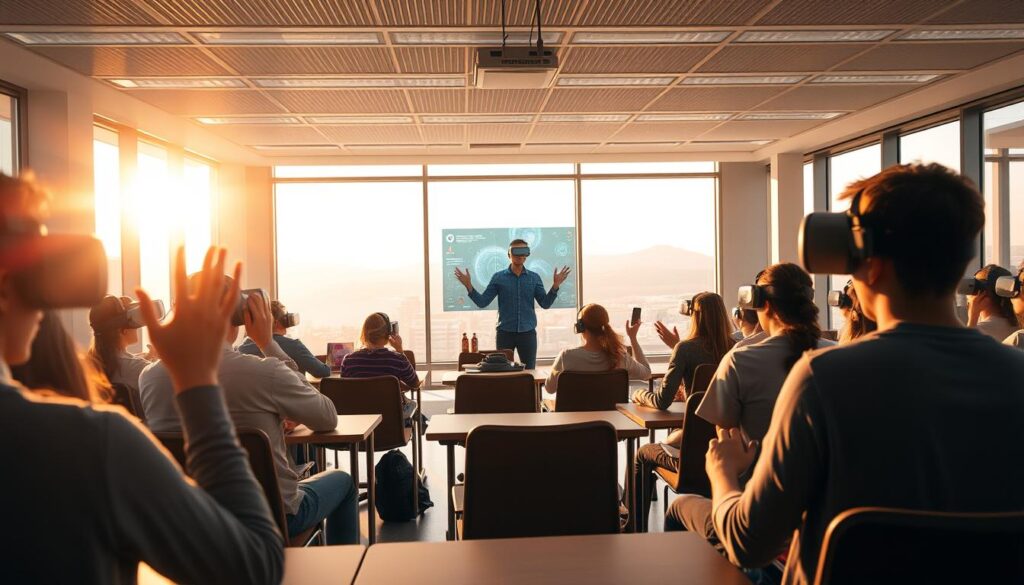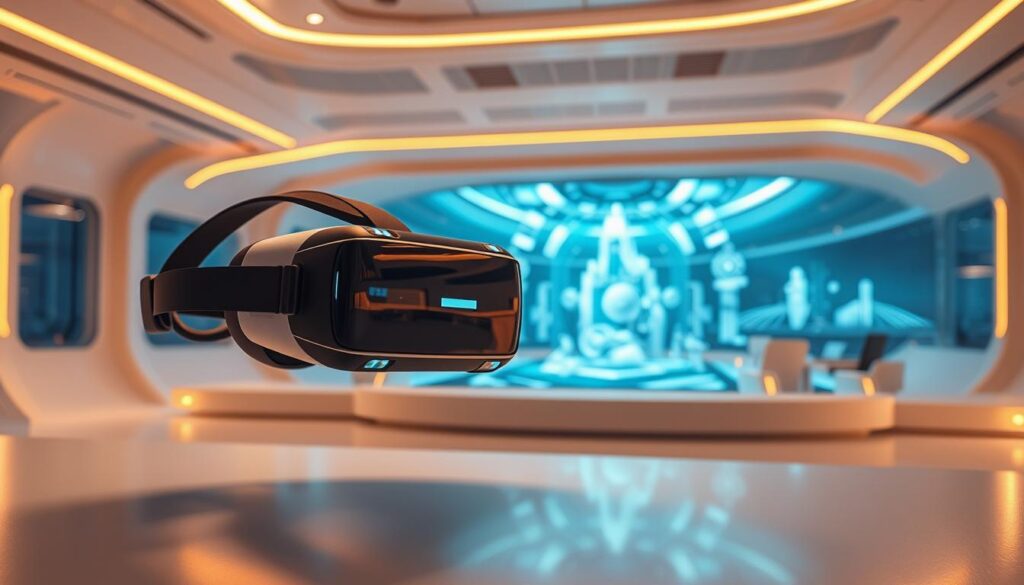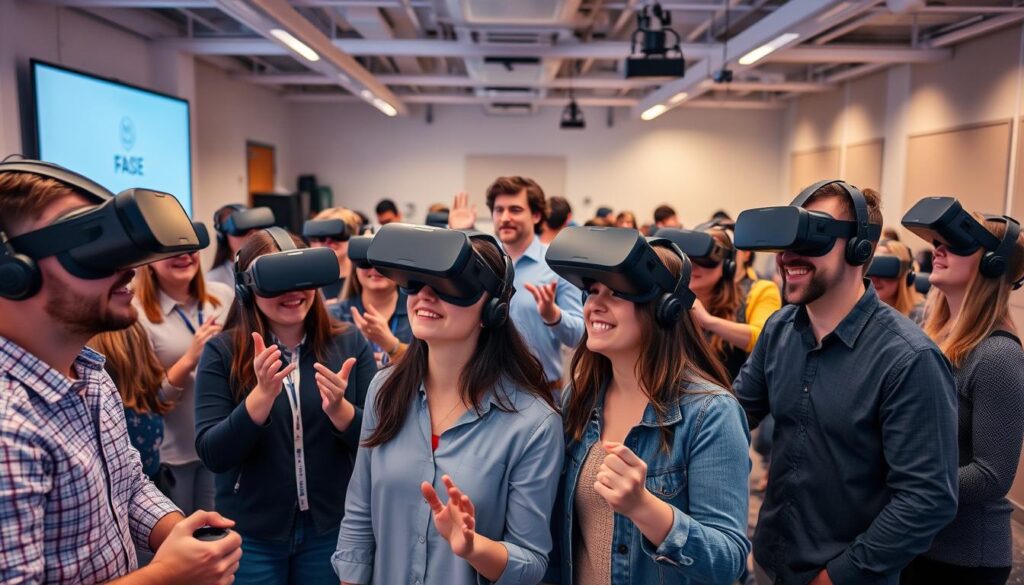Access VR: Ultimate Immersive Learning Breakthrough
15 min read
Table of Contents
Imagine a classroom where students can explore the ocean or visit landmarks without leaving their seats. Immersive learning is changing education, making hard topics fun and interactive.
Access VR leads this change, providing a no-code platform for creating immersive experiences. It doesn’t need a lot of technical knowledge.

Teachers use immersive learning to keep students interested, help them remember more, and make learning fun. Access VR is known for its innovative approach to immersive learning.
The Evolution of Virtual Reality in Learning Environments
VR has changed how we learn and train. It offers immersive experiences that grab learners’ attention and help them remember more. This is a big change in education.
From Complex Programming to Accessible Solutions
Creating VR content used to need a lot of coding skills. This made it hard for schools to use. But now, there are easier ways to make VR content. This means teachers can make learning fun and interactive.
The Need for Scalable VR Learning Solutions
VR is getting more popular in schools. Now, we need ways to use VR that work for everyone. Scalable solutions help schools use VR easily, track how well students are doing, and update their lessons often. This is important for making VR a big part of learning.
Virtual reality creates immersive experiences that closely mirror real life. This makes learning more fun and helps students remember better. Being able to use VR in big schools is key to making VR a big part of education.
Introducing Access VR: A Revolutionary No-Code Platform
Access VR is changing how we learn with its new no-code platform. It lets you make complex VR apps easily, without needing to know how to code.
Company Background and Platform Launch
Access VR started with a team of VR and education experts. They wanted to make VR learning easier and more accessible for everyone. Their goal was to help organizations create engaging VR experiences without the usual hurdles.
Founding Team and Vision
The team behind Access VR knew the challenges of using VR for learning. They wanted to make creating VR content simple. This way, experts in any field could make VR experiences, not just tech developers.
Launch Timeline and Initial Market Response
After lots of development and testing, Access VR launched its platform. The first reactions were very positive. Many organizations saw the value in making VR learning easier and more accessible.
Core Mission and Value Proposition
Access aims to make VR technology available to all for learning and training. Its main benefit is that it lets organizations create and manage VR experiences easily. This means more efficiency, lower costs, and easier VR adoption.
Breaking Down the Barriers to VR Implementation
VR technology has big dreams but faces many hurdles. Mainly, it’s the tech and growing issues that slow it down. Making VR work in many places is hard because of these problems.
Traditional Challenges in VR Adoption
VR’s growth is slowed by a few big challenges. These are:
- Technical complexity and the need for specialized programming knowledge
- High resource requirements, including expensive VR headsets and compatible hardware
Technical Complexity and Resource Requirements
Setting up VR needs a lot of tech know-how. You need to know how to program and model in 3D. Also, VR gear and computers are pricey, making it hard for many to start.
Scalability Issues in Enterprise Settings
Large enterprises encounter unique challenges when scaling virtual reality initiatives. They need strong systems and IT help. Making sure VR works with what they already have is key.
How Access VR Addresses These Challenges
Access VR tackles these problems with a no-code platform. It makes creating and using VR easier. This means less tech skill needed and more doors open for VR use.

Access VR makes growing VR efforts simpler. This helps companies reach their goals in immersive learning and training more easily.
Key Features of the Access VR Platform
The Access VR platform is changing how immersive experiences are made. It makes creating VR applications easy, even for those who don’t know how to code.
Intuitive Drag-and-Drop Interface
The Access VR platform has an intuitive drag-and-drop interface. This lets users easily make and change their VR experiences. It’s so simple, even those without coding skills can create complex VR scenarios.
Pre-built Templates and Scenarios
Access VR also has pre-built templates and scenarios. These are for different industries and needs. They help users quickly make and use VR solutions that fit their needs.
Integration Capabilities with Existing Systems
The Access VR platform works well with other systems. It’s compatible with Learning Management Systems (LMS) and Human Resource Information Systems (HRIS).
LMS and HRIS Compatibility
By working with LMS and HRIS, Access VR makes adding VR training easy. This makes it simple for organizations to use VR technology.
Data Analytics and Reporting Tools
Access VR also has data analytics and reporting tools. These tools give insights into how users are doing and how engaged they are. They help organizations see how well their VR training is working and make better choices.
The Access VR platform is a strong tool for making and using immersive experiences in many fields. It helps organizations improve their training, get users more involved, and achieve better results.
The No-Code Revolution in Virtual Reality Development
No-code platforms are changing VR content creation. Now, people without coding skills can make immersive learning experiences. This change is transforming how companies train and educate.
Democratizing VR Content Creation
The no-code movement in VR is opening doors for more creators. Access VR lets experts focus on making engaging learning experiences. They don’t need to worry about coding.
This shift means we’re getting more diverse learning materials. They’re made for specific needs and industries.
Empowering Subject Matter Experts
With Access VR, experts can lead in making VR learning experiences. This makes the process faster and ensures the content is right and relevant.
From Concept to Deployment Without Technical Expertise
Access VR’s easy-to-use interface lets creators go from idea to live without coding skills. This cuts down on development time and costs.
Collaborative Development Features
The platform also has tools for working together on projects. This helps teams create a cohesive and effective product. It makes sure the final product meets the company’s goals.
Using no-code VR technology, companies can grow their immersive learning. This improves the learning experience and boosts results.
Target Industries and Applications
Access VR’s code-free platform is revolutionizing how organizations deploy virtual reality. It’s opening doors in many fields, letting them use immersive tech without needing to know how to code.
Corporate Training and Development
Access VR is changing corporate training with immersive experiences. It makes learning more engaging and keeps employees interested. Companies can make their own training programs easily with the platform’s drag-and-drop tool.
Education and Academic Settings
In schools, Access VR is making learning fun and interactive. It helps make hard topics easier to understand. The platform has ready-made templates and scenarios for creating engaging educational content.
Healthcare and Medical Training
The healthcare world is also benefiting from Access VR, mainly in medical training. Realistic simulations can greatly improve skills and readiness. It delivers diverse training modules from surgical simulations to realistic patient‐care scenarios.
Surgical Simulation Applications
Access VR lets medical pros practice surgeries in a safe space. This practice can make them better at real surgeries.
Patient Care Training Scenarios
The platform also helps with patient care training. It helps healthcare workers understand and handle different patient situations better. This leads to more caring and effective care.
Access VR is making immersive technologies easier to use in many fields. It’s helping these technologies get used in different areas.
Scaling Immersive Learning Across Organizations
As more companies use immersive learning, it’s key to spread VR solutions across the whole company. Access VR helps by giving a full platform for this, making it easy to share learning experiences.
Deployment Strategies for Enterprise-Wide Implementation
For big-scale immersive learning, companies need good plans. Access has tools and features for this, like an easy-to-use interface and strong integration. This makes it simple to add VR training in many departments and places.
Key deployment strategies include:
- Phased implementation to test and refine the VR solution
- Centralized management to monitor and control the VR environment
- Comprehensive training for administrators and end-users
Measuring ROI and Learning Outcomes
To show the value of immersive learning, companies must track ROI and learning results. Access has analytics and reports to help see how well VR training works.
Performance Metrics and Analytics
Access VR’s analytics let companies follow important metrics like completion rates and user engagement. This info shows how well the training is doing and where it can get better.
Skill Retention and Knowledge Transfer
Immersive learning helps keep skills and knowledge sharp. Access VR’s training programs mimic real-life situations, making learning stick better.
Access VR Technology: Hardware and System Requirements
To scale immersive learning effectively, it’s essential to understand the technical specifications of Access. This knowledge ensures a seamless integration into existing learning environments.
Compatible VR Headsets and Devices
Access works seamlessly with a wide array of VR headsets and devices. This makes it versatile and accessible. It’s key for organizations looking to use their existing hardware.
Meta Quest Integration
The platform supports Meta Quest integration. This allows users to dive into immersive learning easily. No complex setup or extra hardware is needed, just the headset.
HTC Vive and Other Platform Support
Access also works with HTC Vive and other VR platforms. This wide compatibility lets organizations pick the best VR hardware for their needs.
Cloud Infrastructure and Security Features
Access VR uses strong cloud infrastructure for scalability and reliability. This cloud setup makes updates and maintenance easy. It keeps the platform current and secure.
- Scalable cloud infrastructure for flexible deployment
- Enterprise-grade security features to protect user data
- Regular updates and maintenance for optimal performance
By using cloud infrastructure and supporting many VR headsets, Access offers a flexible and secure immersive learning solution.
Early Adopters and Success Stories
Early users of Access VR have seen big changes in their learning programs. They used the platform’s easy-to-use interface to make and share complex VR training. This made it easier than ever before.
Case Study: Fortune500 Implementation
A top Fortune500 company used Access to improve their training. They saw a big jump in how much employees cared and stayed with the company.
Implementation Process and Timeline
Thanks to Access VR’s simple design, the company quickly got started. They made and shared their first VR training in six weeks. This would have taken months with old methods.
Measured Outcomes and Benefits
The results were amazing. The company saw a 30% increase in training efficiency and a 25% cut in training costs. Access VR made learning more fun and effective.

Educational Institution Implementations
Many schools and universities have also started using Access VR. They’ve seen improved student engagement and better retention rates. This shows how Access VR can change education.
The stories of these early users prove Access VR’s impact on learning. As more places use it, the future of immersive learning looks bright.
The Future Roadmap for Access VR
Access is looking to the future with big plans. They aim to innovate and grow. Their goal is to make immersive learning better in many fields.
Upcoming Features and Enhancements
Access VR is getting ready to add new features. They will have better analytics to track how well learners are doing. They also plan to grow their library of templates and scenarios.
Long-term Vision for Immersive Learning
Access sees a future where learning is fully immersive. They are working on several projects to make this happen.
AI Integration and Adaptive Learning
AI is coming to Access. This will make learning adapt to each person’s needs. It dynamically adjusts both the content and challenge level in real time based on your performance.
Cross-Platform Expansion Plans
Access wants to work with more VR devices. This will make their solutions available to more people. It’s all about making learning accessible to everyone.
Conclusion: Transforming the Landscape of Immersive Learning
Access is changing how we learn by making virtual reality easy to use. It’s a no-code platform that’s simple and accessible. This makes it easier for businesses and schools to use virtual reality for learning.
With Access, experts can create great training without needing to know how to code. This leads to better learning experiences. People learn more and remember what they learn better.
The future of learning looks bright with Access leading the way. As it grows, it will change how we train and teach. It will help organizations share immersive learning worldwide.
FAQ
What is Access VR and how does it simplify immersive learning?
Access VR is a no-code platform. It lets organizations create immersive learning experiences easily. You don’t need to know how to code or have technical skills.
What are the benefits of using Access for corporate training and development?
Access makes corporate training better by making it more engaging. It offers immersive learning experiences. These can be easily used and shared across organizations.
What VR headsets and devices are compatible with Access?
Access works with many VR headsets and devices. This lets organizations pick the best hardware for their needs. It also ensures smooth integration with their systems.
How does Access address traditional challenges in VR adoption?
Access tackles VR adoption challenges by being easy to use. It’s a no-code platform that lowers technical complexity. This makes it simpler for organizations to start using VR for learning.
Can Access be integrated with existing systems and infrastructure?
Yes, Access can be integrated with existing systems. This makes it easy for organizations to add immersive learning to their current training programs and systems.
What kind of support does Access offer for deployment and implementation?
Access offers support for deploying and implementing VR across an entire organization. This ensures that immersive learning can be scaled effectively.
How does Access measure the ROI and learning outcomes of immersive learning experiences?
Access includes features to track ROI and evaluate learning effectiveness. This helps organizations see how effective their immersive learning programs are. They can make informed decisions based on data.
What are the future plans and developments for Access?
Access has plans for new features and enhancements. It also has a long-term vision for immersive learning. This includes ongoing innovation and growth of its no-code platform.
Is Access suitable for education and academic settings?
Access excels in educational and academic environments. It offers immersive learning experiences. These can improve student engagement and retention, and lead to better learning outcomes.
What kind of security features does Access offer?
Access has cloud infrastructure and security features. These ensure data is stored and transmitted securely. This protects sensitive information and keeps immersive learning experiences safe.
Reader Ratings & Reviews
There are no reviews yet. Be the first one to write one.
